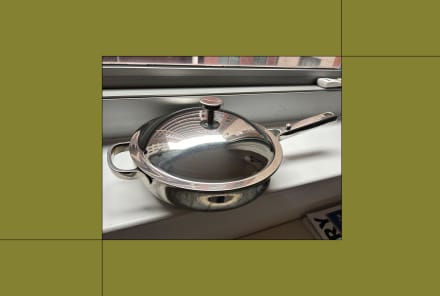Advertisement
Ponytail Palm Care: How To Help This Wild-Haired Succulent Thrive

If successful plant parenthood has seemed elusive, we have your answer! The ponytail palm is a plant that does best with little to no attention. You don't need complicated watering schedules or specially calibrated greenhouses to care for this unique tropical "tree." Just follow these care tips and watch it thrive in your home.
What is a ponytail palm?
Despite its name and appearance, the ponytail palm (Beaucarnea recurvata) is not a palm tree at all. This lush plant, native to Mexico, with its free-flowing ponytail of leaves, is actually a member of the succulent family. And that's exactly why it's known as a low-maintenance houseplant for even the most amateur of green thumbs.
Beatriz Garces of Nature's Way Farms explains, "The ponytail palm is a popular houseplant for its drought-tolerant nature and adaptability to almost any environment. It stores water in its unique trunk, which is why it is so easy to maintain."
While it first became popular in the 1970s, Garces describes the plant's recent moment in the sun, "We have seen a resurgence in popularity of the Ponytail Palm due to its unique appearance. Its exposed, unique, slender trunk paired with thin, green, curly fronds makes the ponytail palm a statement piece on any table."
Now, you can find ponytail palms at most garden stores that sell houseplants. They'll rarely reach over 4 feet when grown inside and are simple to keep at a manageable indoor size.
Caring for your ponytail palm.
You can enjoy the unique, perky nature of this plant inside your home even if you have a busy schedule. Here's what to know about its water, temperature, sun, and soil needs.
Water:
Stuart Mackenzie, a horticulturist at Trees.com, explains, "The ponytail palm stores water in its bulbous trunk, so watering is easy." The plant does best in a desert-like environment, so don't get overzealous with watering; twice a month should suffice.
As with any plant, do your best to keep to a consistent watering schedule with your ponytail palm and dump out any water left over in its saucer so it's not sitting in moisture.
Have to leave town for a few weeks? No big deal. Your ponytail palm will be waiting for you when you get back—and it should be as green as ever. Ayelet Faerman of Verdant Lyfe describes the ponytail palm as, "A great starter houseplant and easy to care for with the ability to leave it for vacation or other travel with no worries." Just give it a thorough watering before you head off, get rid of any standing water, and you'll be good to go.
Temperature:
Since these plants are native to semi-desert areas in Mexico, they thrive in a warm, dry climate and won't do well in below-freezing temperatures. Lindsey Hyland, a gardening expert and founder of Urban Organic Yield, advises keeping your ponytail palm in temperatures between 65 and 75 degrees Fahrenheit.
Sunlight:
Like many members of the succulent family, ponytail palms thrive under bright, indirect light. Garces says, "Placement near a bright window or in a bright room is ideal." If you live in Zones 9 to 10, she continues, "You can also enjoy your ponytail palm as a tabletop plant on any covered patio, porch, or deck."
Faerman adds that when ponytail palms are exposed to brighter light and full sun exposure, there's an added benefit. The plant will take on some red coloring and add a vibrant pop of crimson color to your home garden.
Soil:
For a plant that does best when ignored, it's no surprise that a ponytail palm does not like moist, wet soil. Faerman recommends a palm or cactus soil that allows for maximum drainage and will dry out completely between waterings.
Repotting:
Ponytail palms are slow-growing, and they enjoy being tightly bound within a pot or planter. Mackenzie explains, "It's best to keep the ponytail palm pot bound, and upgrade pots in increments that will keep the roots bound."
Faerman adds, "I would recommend only repotting it once its roots have maximized the pot." You'll know it has reached this point, which may occur biannually, when you push on the outside of the pot and it doesn't give. Look for a pot that's no bigger than 2 inches larger than the bulbous trunk.
Common problems with the ponytail palm.
While they're incredibly easy to care for, there are a few issues that can arise with the ponytail palm. But, if you're aware of them, you can easily get back on track and have your wild-haired succulent looking healthy in no time.
- Root rot: Too many ponytail palms suffer when their owner gets too excited and can't stop themselves from watering daily! Remember, this is a desert-loving plant that thrives in dry, arid conditions, so avoid overwatering at all costs. Allow the soil to dry out completely each time you water to avoid deadly root rot.
- Leaf loss: While overly moist soil can lead to rot, Hyland also points out that ponytail palms can drop their leaves if they're not getting enough water, so don't skip their biweekly drink.
- Brown leaf edges: Yes, its fronds look like hair, but avoid the temptation to give the ponytail palm a new hairdo. Garces says, "Some people like to trim the ponytail fronds; this will lead to browning on the edges of the leaves. If you don't like the brown edges on the fronds, avoid giving them a haircut."
- Mealy Bugs: Faerman says that it may be difficult to eliminate the problem simply by removing the bugs, "Because a ponytail palm has so many leaves or ponytail hairs that can get bunched together, it can become difficult to remove every bug." Instead, she recommends spraying with a defensive spray, like neem oil, once a month to prevent any pest outbreaks from happening in the first place. Here's a comprehensive guide to getting started with neem oil.
How to grow multiple trunks on a ponytail palm.
While propagating a ponytail palm is no easy feat, your plant may slowly develop multiple heads, or "pups" along its trunk that will sprout their own ponytails of fronds.
Faerman says, "New growth 'pups' can be carefully cut from the trunk, rooted, and will eventually form their own trunk over time." It is not as simple a process as some other succulents and plants where a simple cutting quickly turns into a new plant, but it is something to look forward to as you take care of your ponytail palm over the years.
The takeaway.
The beauty of a ponytail palm—beyond its streaming green fronds—is the ease in taking care of it. Less is more when it comes to the ponytail palm: Less water, less attention, less room in the planter, less frequent repotting, and absolutely no trimming. The only thing you'll want more of is sunlight. This is the ultimate low-maintenance entry into plant parenthood to prove to yourself that yes, you have a green thumb too!
Watch Next
Enjoy some of our favorite clips from classes
Enjoy some of our favorite clips from classes
What Is Meditation?
Mindfulness/Spirituality | Light Watkins
Box Breathing
Mindfulness/Spirituality | Gwen Dittmar
What Breathwork Can Address
Mindfulness/Spirituality | Gwen Dittmar
The 8 Limbs of Yoga - What is Asana?
Yoga | Caley Alyssa
Two Standing Postures to Open Up Tight Hips
Yoga | Caley Alyssa
How Plants Can Optimize Athletic Performance
Nutrition | Rich Roll
What to Eat Before a Workout
Nutrition | Rich Roll
How Ayurveda Helps Us Navigate Modern Life
Nutrition | Sahara Rose
Messages About Love & Relationships
Love & Relationships | Esther Perel
Love Languages
Love & Relationships | Esther Perel

















